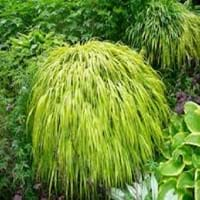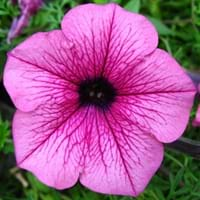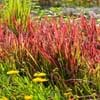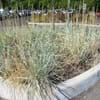Life Span
Perennial
Annual
Type
Grass
Flowering Plants, Shrubs
Origin
Japan
South America
Types
Not Available
Grandiflora Petunias, Multiflora Petunias, Wave Petunias, Superbell Petunias, Supertunia Petunias
Number of Varieties
Not Available
Habitat
meadows, Riverbanks, Wet Woods
Terrestrial
USDA Hardiness Zone
5-9
9-10
AHS Heat Zone
9 - 5
Not Available
Sunset Zone
1a, 1b, 2a, 2b, 3a, 3b, 4, 5, 6, 7, 8, 9, 10, 11, 12, 13, 14, 15, 16, 17, 18, 19, 20, 21, 22, 23, 24
not provided
Habit
Clump-Forming
Not Available
Flower Color
Blue Violet
Blue, Pink, Purple, Red, White, Yellow
Flower Color Modifier
Bicolor
Not Available
Fruit Color
Purple
Not Available
Leaf Color in Spring
Yellow, Green, Light Green
Golden Green
Leaf Color in Summer
Light Green
Green
Leaf Color in Fall
Orange, Yellow green, Orange Red
Green
Leaf Color in Winter
Green, Dark Green, Not Available
Green
Leaf Shape
Oblovate
Ovate
Plant Season
Spring, Summer, Fall
Summer
Sunlight
Full Sun, Partial Sun, Partial shade
Full Sun, Partial shade
Type of Soil
Loam
Loamy, Sandy
The pH of Soil
Acidic, Neutral
Neutral
Soil Drainage
Well drained
Well drained
Bloom Time
Late Summer, Early Fall, Fall
Fall, Spring, Summer
Tolerances
Dry soil, Shallow soil
Pollution
Where to Plant?
Ground
Container, Ground, Pot
How to Plant?
From Rhizomes
Seedlings, Transplanting
Plant Maintenance
Medium
Medium
Watering Requirements
Keep ground moist
Keep the ground moist but not water-logged, Requires regular watering, Requires watering in the growing season
In Summer
Lots of watering
Lots of watering
In Spring
Consistently
Moderate
In Winter
Adequately
Average Water
Soil pH
Acidic, Neutral
Neutral
Soil Type
Loam
Loamy, Sandy
Soil Drainage Capacity
Well drained
Well drained
Sun Exposure
Full Sun, Partial Sun, Partial shade
Full Sun, Partial shade
Pruning
Prune grass to maintain level, Prune if you want to improve plant shape
Cut or pinch the stems, Do not prune during shooting season, Remove dead or diseased plant parts, Remove deadheads
Fertilizers
organic fertlizers
All-Purpose Liquid Fertilizer
Pests and Diseases
Not Available
Aphids, Bacterial Blight, Caterpillars, Gray mold, Leaf spot, Powdery mildew, Root rot, Spider mites, Thripes, Verticillium Wilt, Viruses
Plant Tolerance
Shade areas, Shallow soil, Wet Site
Drought
Flowers
Insignificant
Yes
Flower Petal Number
Single
Not Available
Fragrant Bark/Stem
No
Yes
Foliage Texture
Medium
Medium
Foliage Sheen
Matte
Matte
Attracts
Ants, Beetles, Caterpillar
Butterflies, Hummingbirds
Allergy
allergic conjunctivitis, Asthma, Rash
Not Available
Aesthetic Uses
Beautification, Ground Cover
Beautification, Bouquets, Showy Purposes
Beauty Benefits
Not Available
Not Available
Environmental Uses
Provides ground cover, Shadow Tree
Air purification
Medicinal Uses
Acne, Aging, Laxative
Not Available
Part of Plant Used
Leaves
Flowers
Other Uses
Can be made into a herbal tea, Showy Purposes
Showy Purposes
Used As Indoor Plant
Sometimes
Yes
Used As Outdoor Plant
Yes
Yes
Garden Design
Container, Edging, Mixed Border, Rock Garden / Wall, Water Gardens
Bedding Plant, Container, Edging
Botanical Name
HAKONECHLOA macra 'Aureola'
Petunia
Common Name
Golden Japanese Forest Grass, Hakone Grass
Petunia
In Hindi
जापानी वन घास
Petunia
In German
Japanische gras
Petunie
In French
Forêt herbe japonaise
Pétunia
In Spanish
forestales hierba japonesa
Petunia
In Greek
Ιαπωνικά γρασίδι δάσος
πετούνια
In Portuguese
floresta grama japonês
Petúnia
In Polish
Japoński las lato
Petunia
In Latin
Forest gramina Italica
Petunia
Phylum
Angiosperms
Streptophyta
Class
Monocots
Magnoliopsida
Family
Poaceae
Solanaceae
Genus
Hachanechloa
Petunia
Clade
Angiosperms
Angiosperms, Asterids, Eudicots
Tribe
Not Available
Not Available
Subfamily
Arundinariinae
Petunioideae
Number of Species
Not Available
Season and Care of Japanese Forest Grass and Petunia
Season and care of Japanese Forest Grass and Petunia is important to know. While considering everything about Japanese Forest Grass and Petunia Care, growing season is an essential factor. Japanese Forest Grass season is Spring, Summer and Fall and Petunia season is Spring, Summer and Fall. The type of soil for Japanese Forest Grass is Loam and for Petunia is Loamy, Sandy while the PH of soil for Japanese Forest Grass is Acidic, Neutral and for Petunia is Neutral.
Japanese Forest Grass and Petunia Physical Information
Japanese Forest Grass and Petunia physical information is very important for comparison. Japanese Forest Grass height is 30.50 cm and width 30.50 cm whereas Petunia height is 5.00 cm and width 2.50 cm. The color specification of Japanese Forest Grass and Petunia are as follows:
Japanese Forest Grass flower color: Blue Violet
Japanese Forest Grass leaf color: Yellow, Green and Light Green
Petunia flower color: Blue, Pink, Purple, Red, White and Yellow
- Petunia leaf color: Golden Green
Care of Japanese Forest Grass and Petunia
Care of Japanese Forest Grass and Petunia include pruning, fertilizers, watering etc. Japanese Forest Grass pruning is done Prune grass to maintain level and Prune if you want to improve plant shape and Petunia pruning is done Cut or pinch the stems, Do not prune during shooting season, Remove dead or diseased plant parts and Remove deadheads. In summer Japanese Forest Grass needs Lots of watering and in winter, it needs Adequately. Whereas, in summer Petunia needs Lots of watering and in winter, it needs Average Water.





